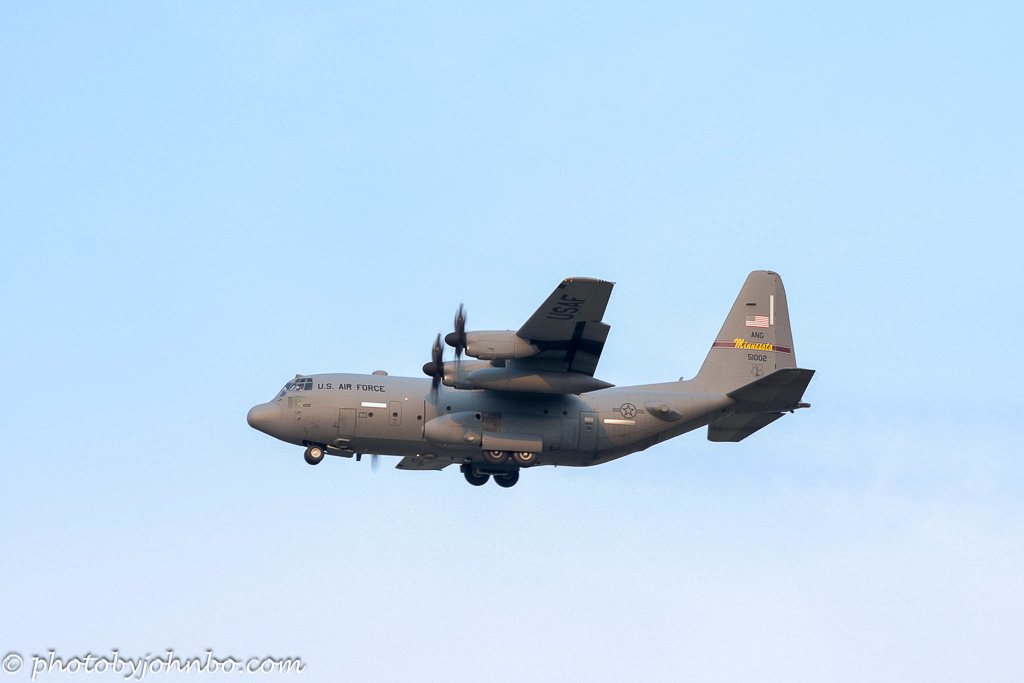
Fargo, North Dakota.
It was the week of the Fargo Airshow (or, as they call it, Fargo Airsho 2024), and early in the week while driving home, we saw a C-130 USAF aircraft fly overhead. That’s not an entirely unusual sight, as the Minnesota Air National Guard often brings a C-130 to Fargo for flight crew currency. That could be their mission for the evening’s flights, or they could be flying in the air show the upcoming weekend, and they scheduled some practice time.
Whatever the case, I had my new Z7 II in the trunk, and we weren’t far from the airport. At that moment, our plans changed. We headed to the small park just outside the airport security fence, an excellent observation point for aircraft departing and arriving on runways 35 and 18. As we parked the car, the C-130 flew over the field, this time not doing a landing and rolling takeoff known as a “touch and go.” I hurried to get the camera ready before the next circuit.
Before the C-130 returned to the field, an Allegiant Airbus A320 landed. We’ve flown Allegiant on several occasions to travel to Phoenix over the years as they have a heavy “snowbird” schedule between Fargo and Mesa, Arizona, in the winter. They also have many other destinations out of Fargo, so I checked Flight Aware and found this arrival was a scheduled flight from Mesa.
I photographed several circuits of the C-130, but Fargo’s Hector International is a busy airport. Again, between C-130 circuits, A United Parcel Service Airbus arrived from Sioux Falls, South Dakota, and taxied up to the UPS terminal.
The UPS freighter departed for Louisville, Kentucky, in less than two hours. In the background, the vendor tents are already in place for the weekend air show.
Some of my earlier photos at 1/800 froze the props, so it looked like the four engines had been stopped. I slowed the shutter speed down to 1/200, and the shots in the air added some blur to the spinning prop. I learned, though, that unless I matched my rotation as I tracked the plane, I got motion blur in the plane’s forward progress. In this shot, I matched the aircraft’s forward speed so it is sharp, but, as expected, the background exhibited motion blur. There is a slight but noticeable blur in the props, as I was hoping to accomplish.
This photo showed a small amount of motion blur in the aircraft as I was just a bit behind in tracking the Lockheed. The rest of this circuit’s shots exhibited too much motion blur. From this, I learned I need a faster shutter speed than 1/200 second. However, I couldn’t tell that from the small display on the back of the camera. I had to wait until I got home to review the images on my larger monitor to see that I missed the mark.
Shortly after the Hercules departed, I was surprised to see a Sun Country Boeing 737 arrive. I knew they planned to add Fargo to their routes, but I expected that to start later this year. This aircraft left Reno, Nevada, about 2.5 hours earlier. It would later depart Fargo for Minneapolis.
A shutter speed of 1/200 worked well for this shot of the Lockheed as it flew over the airport. I think I am ready for the airshow now. I plan to bring a longer lens as I won’t have as close a vantage point, so I will still experiment with the correct exposure prop blur. I will need at least 1/500-second exposures with my longer lens to avoid motion blur in the aircraft, but that will completely eliminate prop motion blur. I will work on my panning skills to keep the shutter speed no faster than 1/200 and try to track the plane’s movement perfectly. If those photos turn out, you’ll see them in a future post. You can forget that I went to the airshow if they don’t. >grin<
As the Lockheed flew by, I captured one more photo before packing my camera and heading home for the evening. For those interested in more information about the military role of the C-130 Hercules, here’s an excerpt from the C-130 USAF fact sheet: “Using its aft loading ramp and door, the C-130 can accommodate a wide variety of oversized cargo, including everything from utility helicopters and six-wheeled armored vehicles to standard palletized cargo and military personnel. In an aerial delivery role, it can airdrop loads up to 42,000 pounds or use its high-flotation landing gear to land and deliver cargo on rough, dirt strips.” The background and more photos of the Hercules can be found here.
If you’ve read this far, thank you. I wrote this post the day after I did this shoot on July 23, two days before the airshow. I write all of my posts a few weeks in advance, so my next opening for this post is at the end of August, a month after the Fargo Air Show. I am scheduled to cover a Meet and Greet with the Blue Angels demonstration team on Friday, July 27, as a photographer for the North Dakota Wing Civil Air Patrol. That story will also be on the schedule.
John Steiner









Beautiful clicks!
These birds look magnificent!
Thanks, Philo. That park is a perfect vantage point for a small zoom lens. I used the 24-120 Z lens at close to maximum zoom.
I must admit, I’ve never considered the complexities of photographing a moving aircraft. I have a feeling my photos would be a blurry mess… or perhaps I’d just miss the plane entirely haha!
Oh, I bet you’d get the hang of it. If you photograph jets, a nice, fast shutter speed, maybe 1/2000 would stop all of the action.
Well done John! Your patience and capabilities are great.
Thanks, Anne!
😍